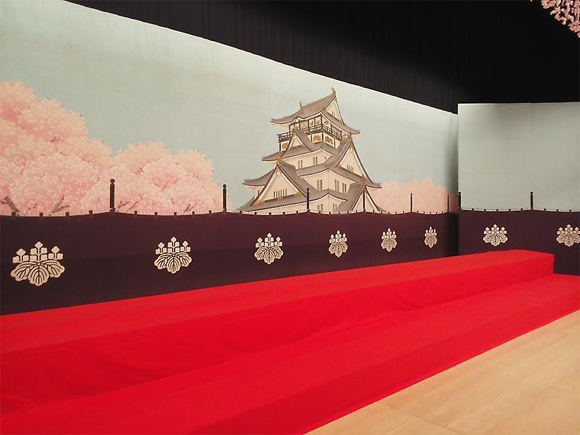| TAIKď SANBASď |
| Play title | Sennari Hisago Mashira no Kaomise |
| Common title | Taik˘ Sanbas˘ |
| Author | Nagawa Sh˘suke (story) Fujima Kanjűr˘ VI (choreography) |
| History |
In the N˘ tradition the ancient and sacred play "Okina" was performed by three characters, the okina (the old man), the senzai (the one thousand years old man), and the sanbas˘ (literally the third old man), to pray for peace and prosperity. Deriving from this tradition in Kabuki there is a ceremonial dance called "Shiki Sanbas˘" which is often performed at the opening of a new theater, for a new year or name-taking Kabuki programs because it is a solemn, auspicious and delightful number fitting to these occasions. The dance of the sanbas˘ became a popular theme in Kabuki and several variations of this dance were created and categorized as sanbas˘mono. "Taik˘ Sanbas˘ is a version integrated within the world of the Taik˘ki with Toyotomi Hideyoshi performing the role of the sanbas˘. It was premiered in April 1981 at the Meijiza by Ichikawa Ennosuke III, within a spectacular drama which was entitled "Sennari Hisago Mashira no Kaomise". Later, it became an independent dance and one of the Ennosuke Shijűhassen (Forty-eight Selected Plays of Ennosuke). It also belongs to the Kaka Jűkyoku. |
| Key words |
Eboshi Ennosuke Shijűhassen Kaka Jűkyoku Kita-no-Mandokoro Nagauta Nene Okina Okina (N˘) ďsaka-j˘ Sanbas˘ Sanbas˘mono Senzai Shosadate Shosagoto Taik˘ Taik˘ki Toyotomi Hideyoshi Yodogimi Yodo-no-Kata |
| Summary |
The scene opens up to the preparation of the ceremonial occasion of the completion of ďsaka Castle. The taik˘ Toyotomi Hideyoshi has decided to perform the sanbas˘ dance on this special event. The festivities begin and Hideyoshi's wife Kita-no-Mandokoro, in the role of the okina, and his mistress Yodo-no-Kata, in the role of the senzai, appear and being a solemn dance. Yodo-no-Kata diverts to a more festive dance, followed by Kita-no-Mandokoro who dedicates a dance to pray for long-lasting peace and eternity of the ďsaka Castle. Then the main personage Toyotomi Hideyoshi appears wearing the traditional eboshi hat and a scarlet costume. His dance is much more animated and lively, shaking the clusters of bells in his hand. But into this festive event the remnants of the enemy clan approach to seek revenge, but Hideyoshi being a well-trained warrior fends off his attackers while he dances. This style of staging is called a shosadate where a stylized combat scene is choreographed into the movements. Hideyoshi completes his offertory dance and wishes eternal prosperity at the foot of the prestigious castle he has just completed. |
 |
|
The stage for "Taik˘ Sanbas˘" |
|
|
| Contact | Main | Top | Updates | Actors | Plays | Playwrights | Programs | Links | FAQ | Glossary | Chronology | Illustrations | Prints | Characters | Derivatives | Theaters | Coming soon | News |